Establishing permanent base pasture
Once the decision has been made to establish permanent pastures in the dairy grazing system and desirable species have been selected, field preparation can begin. Pastures can be seeded either on a prepared seedbed or by no-till drilling, depending on site conditions and crop requirements. With either establishment method, ensure adequate soil fertility is present for rapid crop establishment and growth. This publication discusses soil fertility, site preparation, seeding and time of seeding. Refer to MU Extension publication M181, Dairy Grazing: Selecting the Right Forage, for specific seeding rates and recommended dates.
Fertility
Individual pasture species have different fertility requirements for optimal production. Fertility management can be straightforward with monoculture pastures, that is, pastures with only one plant species. It is more challenging in mixed pastures. In a mixed pasture, the fertility level must be adequate to support the species with the highest requirement in the mixture. The native fertility of the field may be adequate for all species present, but usually fertility is below that required for many desired species.
Many Missouri soils have low pH and respond well to liming. The shape of the yield response curve for lime is similar to that shown in Figure 1. Aluminum and manganese toxicity occurs at low soil pH and severely limits legume growth and persistence. Liming reduces the solubility of these metals and enhances pasture productivity. Most cool-season grasses will persist and be fairly productive with a soil pH of 5.5 and phosphorus (P) level of 20 pounds of available P per acre (according to the Bray I test). Most legumes will respond dramatically to higher fertility levels. Starter fertilizers are usually beneficial for establishment of both grasses and legumes on sites with low P and low pH.
Most pastures in Missouri are low in soil phosphorus unless dairy waste or poultry litter has been applied regularly. Applying phosphorus to these pastures usually gives a good establishment and production response (Figure 1), assuming pH and other nutrients are adequate. Greater economic response to P fertilization occurs with lower initial soil test levels. The same investment is required to increase the soil test level for phosphorus from 10 to 25 pounds per acre as is required to increase from 25 to 40 pounds per acre (according to the P1 test). However, the yield response is only about one-third for the second 15 pounds per acre increase.
Soil testing provides a key tool for determining the basic level of nutrients in the soil and is an appropriate starting point for soil nutrient management. Lime and phosphorus are most beneficial for enhancing establishment if applied at least six months before planting. Early application is even more critical for no-till seedings than it is for conventional seedings. Other fertilizers can be applied at time of seeding and still benefit the establishment process.
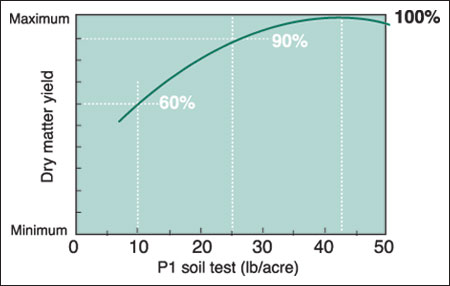 Figure 1. Fertility response is a diminishing returns function with greatest economic response coming on low fertility sites.
Figure 1. Fertility response is a diminishing returns function with greatest economic response coming on low fertility sites.
Time of establishment
Optimal dates for pasture establishment depend on forage species, soil conditions, common insect and disease challenges, and typical climatic conditions. In Missouri and surrounding states, cool-season forages usually establish more successfully with late-summer seeding than with spring seeding. Late-summer seeding at these latitudes occurs in late August and early September. One reason for better establishment with late-summer seeding is fall weather. Fall conditions favor cool-season forage growth, whereas summer conditions restrict growth. Hot, dry conditions in late spring and early summer often result in stand failure with spring seedings. Dry fall conditions may reduce the rate of establishment in some years, but in most years, rainfall in September and October is adequate to ensure stand establishment. Other reasons for better establishment in the fall are weed pressure and insect predation, which are generally more severe in the spring, although grasshoppers and fall armyworms can be a problem in late-summer seedings. Newly seeded fields should be regularly scouted in both spring and late-summer seedings to diagnose pest challenges early in the establishment process.
If only grasses are being established in the pasture, all seeding may be done in late summer. Alfalfa can be established in either spring or late summer. In regions where sclerotinia crown and root rot is a recurrent problem, spring seeding of alfalfa is advised. Alfalfa and companion grasses can be seeded at the same time with late-summer establishment.
For mixed pastures of cool-season grass and legumes other than alfalfa, the ideal practice is to seed grass in late summer, then the legume in later winter. Broadcasting legumes in late winter is called “frost seeding” (Figure 2), a practice that works well with red clover, white clover and annual lespedeza. For a grass-birdsfoot trefoil mixture, both can be seeded at the same time without risk of the legume crowding out the grass; birdsfoot trefoil has poor seedling vigor.
Warm-season grasses are best seeded in the spring when conditions are favorable for corn planting. Low soil temperature limits germination of warm-season grasses, but the cold soil breaks seed dormancy for many warm-season species and increases overall germination rate. Risk of late frost damage on warm-season grasses is fairly low because the soil temperature requirement usually prevents early germination.
An alternative to spring seeding of warm-season grasses is dormant-season seeding. In this practice, the seed is sown in late fall or early winter after soil temperature drops below the germination requirement. Dormant-season seeding has two advantages:
- It eliminates the risk of delayed planting because of wet spring soils.
- The cold soil of the winter season can remove much of the seed dormancy. When conditions are favorable for spring germination, the seed are present in the soil and ready to sprout.
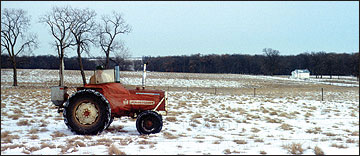 Figure 2. Frost seeding of legumes in late winter works well for red clover, white clover and annual lespedeza.
Figure 2. Frost seeding of legumes in late winter works well for red clover, white clover and annual lespedeza.
Method of establishment
Pastures can be established either in a conventionally prepared seedbed or with no-till seeding. No-till is an attractive option for spring establishment of cool-season forages, as spring soil moisture often restricts the opportunity for tillage (Figure 3). Warm-season grasses or forages established in the fall are planted at a time when the weather is conducive to tillage. Late-summer no-till seeding into a chemically killed sod can conserve soil moisture better than late-summer tilled seeding. The additional moisture available in no-till settings can enhance the establishment rate. Chemically killing the existing sod several weeks before seeding effectively mulches the soil and is more beneficial than killing the sod immediately before drilling.
Because of the small seed size of many forage crops, good seed-to-soil contact is essential for rapid, uniform germination. A smooth, firm seedbed is the objective of conventional seedbed preparation. Working the ground well ahead of seeding is advisable, then sowing the crop after light tillage following a rain is ideal. For most species, seeds should be placed no deeper than 1/4 to 1/2 inch. Only large-seeded forages such as eastern gamagrass, hairy vetch or cereal grain crops should be planted any deeper. When drilling small seed, some seed should be visible on the ground behind the drill runs. If seed cannot be seen on the surface, seed is likely being sown too deep for good emergence.
The two most important considerations for successful no-till establishment are seeding depth and coverage. Because no-till drills are designed to cut into firm soils, they can place the seed too deep if not closely regulated. Drills that have depth-control bands on the disc openers provide the most accurate seed placement. Drills that are designed for no-till planting of row crops are the least useful for pasture establishment. Whereas covering seed in conventionally tilled seedbeds can be done with almost any type of press wheel, closing a slot made by a no-till drill in firm ground is more challenging. And if the slot is not properly closed, dry weather can lead to severe soil cracking along the slot, leaving seedling roots at risk of drying out and dying. A single large-cast press wheel with a raised bead that follows directly behind the opener provides adequate closure. Narrow double press wheels angled in toward the drill slot are also effective. Single, broad flat-surfaced press wheels, however, are ineffective for no-till coverage.
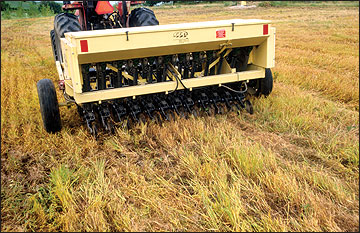 Figure 3. No-till seeding is an attractive option for establishment of cool-season forages.
Figure 3. No-till seeding is an attractive option for establishment of cool-season forages.
Interseeding companion forages into the “base sod”
Companion forages are those forages that can be interseeded into the base sod to create a mixed pasture. In Missouri, common companion crops are legumes interseeded into perennial cool-season grasses.
Establishing most companion legumes into a grass sod is not complicated. Successful interseeding depends on managing the grass canopy. Certain management practices in the fall and spring will expedite legume establishment. If the grass is stockpiled in the fall and grazed through the winter, the stand will be thin during the following spring. This thin stand provides an “open canopy,” which allows light to reach the legume seedlings. The grass should not be fertilized with high rates of nitrogen (N) in the spring because the nitrogen will encourage the grass to become too aggressive, thereby crowding out the newly germinated legume seedlings.
For legume seedlings to become established in grass sods, the existing vegetation must be controlled. Competition exists both above and below ground and should be considered at both levels. Above ground, plants compete for physical growth space and sunlight. Below ground, they compete for water and soil nutrients.
The existing sod should be managed with consideration of the competition at both levels. Simply keeping the grass short may not be adequate if a vigorous root system still exists below ground. Weakening the existing root system is critical for legume establishment. Existing vegetation can be managed through grazing, mowing, tillage, burning, chemical application or a combination of practices.
Grazing
If only grazing is to be used for vegetation control, timing is critical. Assuming a spring legume interseeding, heavy grazing pressure should be applied the previous fall and through winter if necessary (Figure 4). The strategy is to weaken the grass root system to reduce root vigor and competition for water the following spring. Grazing a vigorous sod only in the spring may be adequate for reducing aboveground competition for sunlight but may be inadequate for minimizing belowground competition. Grazing pressure should be maintained in the spring until the legume seedlings have emerged and produced three or four true leaves. Once legumes have reached this stage, rotational grazing should be employed to periodically top graze the sward to keep the canopy fairly open, allowing sunlight to reach the legume seedlings.
Soil moisture should be closely monitored in grazing situations. Cattle should be removed from the pasture if soil moisture is such that their hooves are making imprints more than an inch deep in the soil. The damage to new seedling stands caused by grazing when the soil is too wet usually outweighs the stand reduction that can occur if the grass is allowed to become a little more competitive.
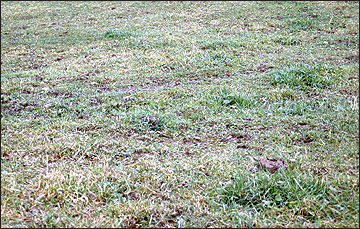 Figure 4. Heavy grazing should be applied during the fall and winter before spring legume interseeding.
Figure 4. Heavy grazing should be applied during the fall and winter before spring legume interseeding.
Mowing
As with grazing, mowing as a practice to control existing sod should begin the fall before seeding (Figure 5). Usually, mowing in October will cause the grass to use stored carbohydrates and will thus reduce the spring growth rate. In the spring, two or three mowings may be required to minimize spring competition. Each subsequent mowing in the spring should leave the grass little taller. Mowing for hay when the grass is in the boot stage will usually result in good legume regrowth in the summer.
 Figure 5. Mowing in the fall before seeding reduces spring growth, thus reducing competition and aiding establishment.
Figure 5. Mowing in the fall before seeding reduces spring growth, thus reducing competition and aiding establishment.
Tillage
In dense sods such as well-established smooth bromegrass or tall fescue, light tillage (Figure 6) may help ensure legume establishment. Disking with the gangs set at a minimal angle will provide adequate disturbance in most cases. If soil conditions are good, a field cultivator can be used effectively, but a finishing disk generally gives best results. Disturbing as little as 25 percent of the sod cover can greatly increase the success rate of interseeding.
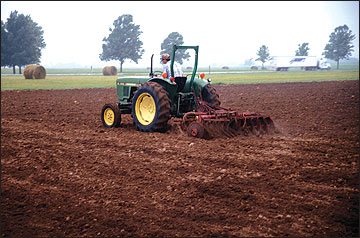 Figure 6. Light tillage helps ensure establishment of legumes in dense sod.
Figure 6. Light tillage helps ensure establishment of legumes in dense sod.
Burning
An early spring burn, just after the cool-season grass begins spring growth, can provide excellent spring vegetation control. Burning too early, before green-up, can result in more vigorous grass growth and actually increase competition. Burning too late may result in an inadequate burn, as too much new green growth prevents a fire from effectively cleaning a field. An inadequate burn will also result if the field does not have enough residual dry matter to serve as fuel. As with any fire practice conducted on pasture or rangeland, make sure you have a plan for controlling the fire and providing rapid fire-control response if necessary.
Weed infestations can occur following a burn of old established pastures, so be prepared to apply weed control measures if necessary.
Chemical control
Broad-spectrum herbicides such as Gramoxone and Roundup can be used for chemical renovation of pastures. Existing sods may be either temporarily suppressed by using lower rates of herbicide or virtually eliminated by using higher rates. Chemical suppression of the existing sod is particularly useful in dry years. Reduction of the evapotranspiration rate, that is, the rate at which the soil loses water, will often determine the success or failure of legume interseedings when moisture is limiting.
A single application of Gramoxone or Roundup shortly after spring green-up will usually provide adequate vegetation suppression for legume establishment without eliminating the existing grass stand. Spraying and using a no-till drill is an effective establishment combination.
Frost seeding
Optimal seeding methods vary by legume species. In Missouri, frost seeding is highly effective for many legume species. Legume seed is broadcast onto the soil in January or February, when the freezing and thawing of late winter stretches the soil, pulls the seed slightly under the surface, and provides good seed-to-soil contact.
The seed must come in contact with the soil for frost seeding to be effective. For this reason, one of the vegetation control methods described above must be implemented. Spring grazing will allow some of the seed to be trampled into the soil, if soil moisture is not excessive. If chemical suppression of the sod is to be used, it should be done the previous fall. Frost seeding is much less effective when herbicides are not applied until spring after green growth has begun. Pasture burning to retard cool-season grass growth in the spring generally occurs too late as legume seedlings should already be up and growing by the optimal fire date. However, broadcast seeding immediately into the ash bed following a burn has been reported to be successful. Sod disturbance combined with frost seeding works well as the roughened soil surface is more conducive to good seed-soil contact due to freezing-thawing activity.
To be successfully frost seeded, a species must be tolerant to cold weather while in the seedling stage. Red and white clover can be frost seeded with consistent success because of their high seedling vigor and frost tolerance in the seedling stage. Although susceptible to freezing in the cotyledon stage, these clover species become hardy after the emergence of the first trifoliate leaf. Lespedeza can be frost seeded successfully because the soil temperature required for germination is substantially higher than for cool-season legumes. Lespedeza generally does not germinate until the risk of a late frost has largely passed.
Alfalfa and birdsfoot trefoil are less tolerant of cold temperatures in the seedling stage and are thus more susceptible to stand failure when frost seeded. Their seedling vigor is also somewhat lower than for red clover, and both are much less shade tolerant than red clover. Alfalfa is best seeded later in the spring using no-till establishment.
Establishing birdsfoot trefoil into a grass sod is more difficult than establishing the other legumes. It can be done only with good management and patience. Because birdsfoot trefoil has poor seedling vigor, the fall stockpiling and spring fertility practices mentioned above are highly advised. Birdsfoot trefoil can be planted using no-till into a thin spring canopy, usually in late March. Even with these management practices and excellent seeding conditions, the first-year mixture may contain only 5 percent birdsfoot trefoil. However, it can thicken over a three-year period if allowed to reseed during June or July and if N fertilizer rates are minimized.
If pastures are to be harrowed for manure dispersion, broadcast seeding at the same time often gives better results than simply frost seeding, particularly with birdsfoot trefoil and alfalfa. If a harrow is used, seeding can be delayed until later in the spring after the risk of late frost is lessened. The chance of success increases if slight sod disturbance is combined with broadcast seeding and harrowing.
No-till drilling
Any of the common legumes can be established using a no-till drill in combination with any of the sod-suppression methods already described. Seeding date can be delayed until all risk of frost has passed. The drill ensures good seed-soil contact, and emergence is typically much quicker and more uniform than with broadcast seeding methods. Crops with higher seed price, such as alfalfa and birdsfoot trefoil, can be seeded with much greater confidence of success when using a drill. Optimal drilling dates will range from mid-March in southern Missouri to mid-April in northern Missouri.
Interseeding “filler forages”
For cool-season grasses, filler forages are primarily warm-season annuals. Annual lespedeza can be established into a cool-season grass such as orchardgrass by frost seeding or no-tilling, then grazed as a pure crop in the summer. For frost seeding, annual lespedeza should be broadcast in late January or in February. For no-till, it can be seeded in March or April. Annual lespedeza will naturally reseed if allowed to rest 40 days, the first day beginning in late summer; in mid-Missouri, this 40-day period begins Sept. 1.
Other filler forages for a cool-season grass pasture include crabgrass, sorghum-sudangrass and pearlmillet. Crabgrass can be drilled or broadcast into a cool-season perennial grass sod. If broadcast, it should be seeded early enough to allow for livestock trampling, as optimal establishment of crabgrass occurs with light tillage. Sorghum-sudangrass and pearlmillet can be no-till drilled directly into a cool-season grass sod. If drilled into an endophyte-free tall fescue sod, strip-killing before drilling can enhance establishment; strip-killing involves spraying bands of a nonselective herbicide, then planting directly into the killed stubble.
Filler forages for warm-season perennial grasses such as caucasian bluestem or bermudagrass include winter cereal crops; however, a moderate to heavy canopy of winter annual crop will crowd out caucasian bluestem. Establishing these into bermudagrass involves drilling two bushels per acre directly into the sod with a standard no-till drill. If wheat, rye or triticale are drilled in early September, they can be grazed throughout the winter. In addition to the winter cereal crops, another filler forage is annual ryegrass, which can be drilled and grazed in the same time period as the cereals.
Replacing endophyte-infected tall fescue: A special case
Replacing a field of endophyte-infected (E+) tall fescue with another crop is not straightforward. It requires spraying out the old tall fescue, planting a smother crop and spraying again before the new crop can be planted. This process is known as the spray-smother-spray technique, and all three steps are important. The technique is designed to replace old tall fescue with another cool-season grass, not a warm-season crop.
The initial spray does not kill all the infected tall fescue tillers. Tillers can reappear and spread to fill an entire pasture. To prevent this, a tall smother crop is planted. The smother crop not only crowds out the escape tillers, it also forms a thick canopy over the tillers and prevents them from receiving sunlight. From a production perspective, the smother crop provides forage while the perennial forage is out of production. The smother crop can be grazed or clipped; then the surviving escape tillers can be eradicated with the second spray.
If the new crop is to be planted in the fall, the old tall fescue should be killed in the spring and its escape tillers smothered over the summer (Figure 7). An effective smother crop in this case would be sorghum-sudangrass, an annual species that forms a dark canopy and grows well during dry summers. If the new crop is to be planted in the spring, the old tall fescue should be sprayed out during the early fall and escape tillers smothered with a winter annual, such as wheat or rye (Figure 8).
If the spray-smother-spray technique is followed and the new cool-season crop is well established, E+ tall fescue is not likely to reappear. Reappearance of E+ tall fescue sometimes occurs when the new crop is a warm-season forage. A warm-season forage does not form a canopy over the newly killed tillers. Therefore, light penetrates the stubble and provides energy to seedlings that emerge from seed in the seed bank, most of which would be E+ tall fescue.
Reappearance of E+ tall fescue can also occur when the newly established cool-season grass lacks persistence. The lack of persistence in perennials such as orchardgrass and perennial ryegrass can result in a thin stand, thereby allowing light to support recently germinated seedlings of E+ tall fescue. In cases where the new forage is likely to thin, interseeding a nonaggressive companion legume, such as birdsfoot trefoil, may be wise. The birdsfoot trefoil would grow into thinned areas, preventing exposed soil and providing a high-quality component to the new pasture.
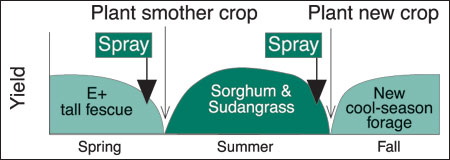 Figure 7. Replacing endophyte-infected tall fescue with a fall-planted cool-season forage: example of spray-smother-spray with a summer smother crop.
Figure 7. Replacing endophyte-infected tall fescue with a fall-planted cool-season forage: example of spray-smother-spray with a summer smother crop.
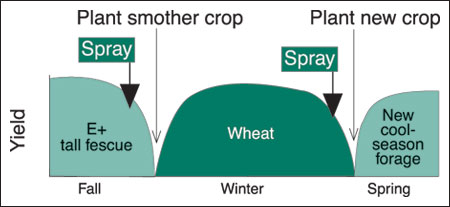 Figure 8. Replacing endophyte-infected tall fescue with a spring-planted cool-season forage: example of spray-smother-spray with a winter smother crop.
Figure 8. Replacing endophyte-infected tall fescue with a spring-planted cool-season forage: example of spray-smother-spray with a winter smother crop.
Table 1. Forage seeding failure.
Type of failure: Live seed does not germinate.
Possible cause
- Impermeable seed coat: This can be overcome by scarifying seed.
- Not enough air: This occurs because seed were sown too deeply or in wet soils.
- Not enough moisture.
Type of failure: Seedlings die immediately after germination.
Possible cause
- Drying
Seed placed in loose surface soil may germinate after a light rain, then dry out before developing sufficient roots for establishment. - Freezing
Seed are sensitive to freezing as the young root breaks the seed coat; temperatures below –3 degrees Celsius, or about 27 degrees Farenheit, are lethal. Soil coverage reduces the likelihood of injury; and once rooted, seedlings can withstand much lower temperatures. - Light coverage
Soil cover or mulch protects against both drying and freezing; without it, seed establish only when soil surface remains moist for extended periods. - Heavy coverage
Most waste of seed probably occurs this way. - Crusted soil surface
This can prevent emergence, especially when seed are sown deeply on fine-textured soils. - Toxicity
Seed in direct contact with banded fertilizer, improper use of herbicides, herbicide carryover, and autotoxicity can damage seed and young seedlings.
Type of failure: Seedlings die after establishment.
Possible cause
- Undesirable pH
Lime should be applied according to soil test to provide a desirable pH; calcium and magnesium should be applied as nutrients. - Low fertility
Soil should be tested to ensure adequate phosphorus, potassium or other nutrients. - Inadequate legume inoculation
- Poor drainage
Water accumulation on the surface or in the soil profile can limit growth - Drought
This is the reason most commonly given for stand failures - Seedling vigor
Some forages, including nurse crops, can compete with forage seedlings for water, light and nutrients. - Insects and pests
- Winterkill
Seeding too late in the fall or seeding poorly adapted cultivars can cause winterkill.
Adapted with permission from Vough, L. R., A. M. Decker, and T. H. Taylor. 1995. Forage establishment and renovation. P. 42 in Barnes, Miller and Nelson, editors. Forages, fifth edition, Iowa State University Press, Ames.
This publication replaces Chapter 7, Pasture Establishment, in MU Extension publication M168, Dairy Grazing Manual.